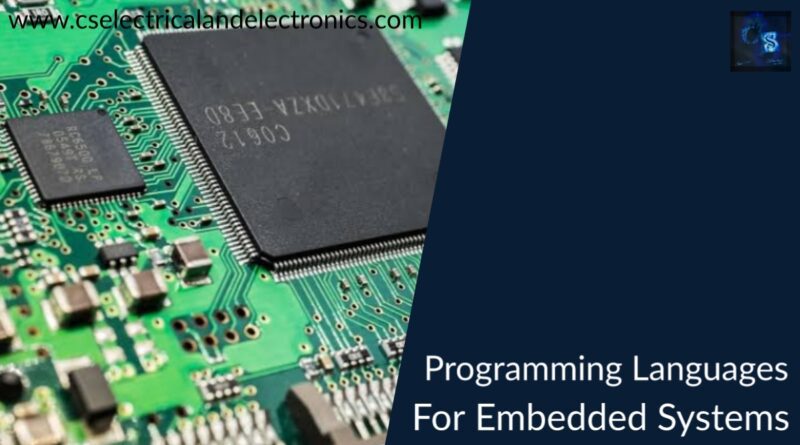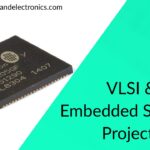Top 15 Programming Languages For Embedded System In 2022
Hello guys, welcome back to my blog. In this article, I will discuss the top 15 programming languages for embedded systems in 2022, which is the best language for embedded systems, which language is used for microcontrollers, etc.
If you have any electrical, electronics, and computer science doubts, then ask questions. You can also catch me on Instagram – CS Electrical & Electronics.
Also, read:
- What Is MongoDB, Tutorial On MongoDB, CURD Operation In MongoDB.
- Difference Between Cascaded H-Bridge, Flying capacitors, Diode Clamped multilevel inverter.
- Top 20 Projects On Proteus Software For Engineers, Diploma Students.
Programming Languages For Embedded System
Because embedded systems programmers confront a variety of resource constraints, they frequently select languages with a small memory footprint.
Such innovations are best suited to old-school programming languages that provide very low-level hardware access. The top programming languages for embedded systems for programming your next embedded device are listed below.
01. C Programming
C’s built-in pointer provides access to even the most low-level device components. Because of its widespread popularity, developers can easily build C compilers for their embedded systems. C is a programming language that blends Assembly’s low-level features with modern programming conventions.
C’s loose data typing policy makes it ideal for programming embedded systems. Embedded programs are much easier to port across platforms than programs written in other languages.
02. C++
Inline functions can be used instead of macro definitions in C++, which is something C lacks. C++ is much safer than its predecessor thanks to its clever use of templates and verbose casting. C++ is an excellent choice for embedded systems programming because it supports overloaded functions and constructors.
C++’s object-oriented design enables programmers to create even the most complex embedded systems without running out of memory. The namespace function in C++ ensures that your program does not crash due to naming conflicts.
03. Java
Writing extensible, portable, and downloadable embedded systems software is much simpler with Java. Java is a good choice for embedded systems programming because it has a lot of developer tools and versatile libraries. Since Java programs are run within the Java Virtual Machine, they are machine-independent (JVM).
Java allows programmers to separate the essential parts of their embedded software from the rest of the code. Java programs are extremely fast and run smoothly even on older hardware.
04. Python
Python is an interpreted language, which means that you’ll need a Python runtime to use it. Python is the most practical language for automating tests for real-time embedded systems. Python makes parsing log files and processing photos a breeze. Python is particularly good at creating real-time data processing embedded systems.
Python is, without a doubt, the best language for writing networking code in cutting-edge embedded systems. Python makes prototyping applications very easy, making it ideal for designing embedded programs in a short amount of time.
05. Rust
Rust’s resource management is extremely versatile, allowing developers to assign memory in both dynamic and static ways. Rust’s awe-inspiring concurrency model is reliable, ensuring that no two threads occupy the same state at the same time. Developers can easily incorporate Rust into their existing C or C++ codebase without any difficulty.
Rust helps you to easily port your embedded system’s code through a wide variety of platforms, from tiny microcontrollers to powerful SBCs. Rust has a strong group behind it, ensuring that embedded systems programming never comes to a halt.
06. Ada
Ada is the best programming language for embedded systems that need to be highly dependable. Ada has produced hundreds of pieces of embedded military equipment for the US Department of Defense (DoD). Different Ada packages can be compiled in different ways and integrated into your framework as required.
Unallocated memory, buffer overflow errors, range violations, and off-by-one errors are all common bugs that Ada’s runtime checks will protect against. Ada’s dynamic dispatch function enables the embedded application to make the most of polymorphism.
07. JavaScript
JavaScript is a dynamic language similar to Python and Ruby in terms of syntax. JavaScript is a good choice for developing fast and stable embedded software because of the large number of developer tools and third-party libraries available. JavaScript use in embedded systems programming is growing daily after Mozilla released ASM.js.
JavaScript’s event-driven, functional programming model can be used to quickly create stable embedded systems. Regular expression parsing is supported natively in JavaScript. As a result, you won’t need any other libraries to complete this time-consuming process.
08. Go
Go has built-in unit testing tools, making it simple to test the embedded program. This embedded systems programming language’s extensive API documentation is useful to both new and experienced developers. Go uses a C-like syntax that is simple to read and remember.
Despite its object-oriented capabilities, Go is easy to learn even for the most inexperienced programmers. Go programs are simple to compile and install on your machine.
09. Lua
Lua allows you to describe and modify functions as first-class values, making object-oriented programming easier. Lua’s fallback mechanism makes it simple to extend programs written in the language.
Lua’s reflexive capabilities allow programmers to build extremely polymorphic components. Lua programs can be used alongside C programs with ease.
10. B#
B# was created with the sole purpose of programming embedded systems in mind. Its syntactical features are very similar to those of C and C++. Boxing and unboxing transformations are simple in B#.
Multi-threading statements, field properties, system addressing registers, interrupt handlers, and a deterministic memory defragmenter are among the other features of this embedded programming language. B# is particularly well suited to small-scale architectures with memory constraints.
11. Assembly Language
Assembly offers the low-level access needed to efficiently manipulate hardware. Since Assembly programs can now be tracked with pinpoint accuracy, discovering the pesky bug is now just a matter of time.
Assembly-based embedded applications are memory efficient and fast. In embedded systems programming, assembly language is used to solve important performance problems in low-resource systems.
12. C#
Structured programming and object-oriented programming are also supported natively in C#. Good form and array bounds testing features catch a lot of hard-to-find runtimes errors during compilation.
C# programs are conveniently scalable and can be used in a variety of architectures without difficulty. One of the driving forces behind the growth of C# was embedded systems programming. The majority of C# programs are memory and processor-efficient.
13. Verilog
Developers can monitor the propagation delay and signal strength of their embedded device using Verilog. It has two task operators: one for blocking assignments and one for non-blocking assignments.
It’s a Dataflow Programming Language. Verilog lets you create custom hardware to meet the needs of your embedded device. In the Verilog programming language, variables must have a fixed size.
14. VHDL
Synthesis software is usually used to process VHDL programs. In most modern embedded devices, VHDL can handle parallel processing very well. Since it is not case-sensitive, uppercase and lowercase typing seem to be the same.
In primitive architectures, it can be used as a general-purpose text processing language. VHDL, like Verilog, is a Dataflow language.
15. Embedded C++
It’s a subset of the widely used C++ language. To compile embedded programs written in Embedded C++, any standard C++ compiler can be used. Many C++ core functionalities that aren’t specifically used in embedded systems programming are removed in Embedded C++ to prevent unnecessary memory usage.
The Runtime type identification (RTTI) function of C++ is absent from embedded C++. For optimization, programs written in this language need an EC++-specific compiler.
Several factors will influence which embedded systems programming language is best for your project. Each implementation necessitates a unique collection of approaches and, as a result, distinct programming languages. Hopefully, you’ve acquired the knowledge you need to choose the right fit for your project.
These are the top 15 programming languages for embedded systems. I hope this article “Programming Languages For Embedded System” may help you all a lot. Thank you for reading.
Also, reading:
- 100+ C Programming Projects With Source Code, Coding Projects Ideas
- 1000+ Interview Questions On Java, Java Interview Questions, Freshers
- App Developers, Skills, Job Profiles, Scope, Companies, Salary
- Applications Of Artificial Intelligence (AI) In Renewable Energy
- Applications Of Artificial Intelligence, AI Applications, What Is AI
- Applications Of Data Structures And Algorithms In The Real World
- Array Operations In Data Structure And Algorithms Using C Programming
- Artificial Intelligence Scope, Companies, Salary, Roles, Jobs
Author Profile
- Content Writer
Latest entries
 All PostsAugust 25, 2021Top 16 Highest Paying Engineering Jobs in the USA For Freshers
All PostsAugust 25, 2021Top 16 Highest Paying Engineering Jobs in the USA For Freshers All PostsAugust 23, 2021Top 10 Smart Cities In The World, Best Cities To Visit In The World
All PostsAugust 23, 2021Top 10 Smart Cities In The World, Best Cities To Visit In The World All PostsAugust 21, 2021Top 20 VLSI & Embedded Systems Projects for Mtech Students
All PostsAugust 21, 2021Top 20 VLSI & Embedded Systems Projects for Mtech Students All PostsAugust 21, 2021Top 20 Power Systems Projects For MTech Students, Engineering Students
All PostsAugust 21, 2021Top 20 Power Systems Projects For MTech Students, Engineering Students








